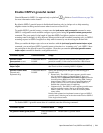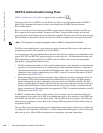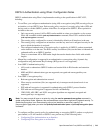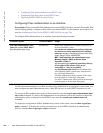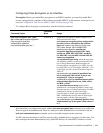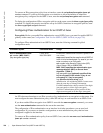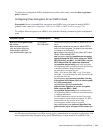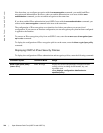
Open Shortest Path First (OSPFv2 and OSPFv3) | 735
OSPFv3 Authentication using IPsec: Configuration Notes
OSPFv3 authentication using IPsec is implemented according to the specifications in RFC 4552,
including:
• To use IPsec, you configure an authentication (using AH) or encryption (using ESP) security policy on
an interface or in an OSPFv3 area. Each security policy consists of a security policy index (SPI) and
the key used to validate OSPFv3 packets. After IPsec is configured for OSPFv3, IPsec operation is
invisible to the user.
• Only one security protocol (AH or ESP) can be enabled at a time on an interface or for an area.
IPsec AH is enabled with the
ipv6 ospf authentication command; IPsec ESP is enabled with the
ipv6 ospf encryption command.
• The security policy configured for an area is inherited by default on all interfaces in the area.
• The security policy configured on an interface overrides any area-level configured security for the
area to which the interface is assigned.
• The configured authentication or encryption policy is applied to all OSPFv3 packets transmitted
on the interface or in the area. The IPsec security associations (SAs) are the same on inbound and
outbound traffic on an OSPFv3 interface.
• There is no maximum AH or ESP header length because the headers have fields with variable
lengths.
• Manual key configuration is supported in an authentication or encryption policy (dynamic key
configuration using the Internet Key Exchange (IKE) protocol is not supported).
• In an OSPFv3 authentication policy:
• AH is used to authenticate OSPFv3 headers and certain fields in IPv6 headers and extension
headers.
• MD5 and SHA1 authentication types are supported; encrypted and unencrypted keys are
supported.
• In an OSPFv3 encryption policy:
• Both encryption and authentication are used.
• IPsec security associations (SAs) are supported only in transport mode (tunnel mode is not
supported).
• ESP with null encryption is supported for authenticating only OSPFv3 protocol headers.
• ESP with non-null encryption is supported for full confidentiality.
• 3DES, DES, AES-CBC, and NULL encryption algorithms are supported; encrypted and
unencrypted keys are supported.
• To configure an IPsec security policy for authenticating or encrypting OSPFv3 packets on a physical,
port-channel, or VLAN interface or OSPFv3 area, perform any of the following tasks:
• Configuring IPsec Authentication on an Interface
• Configuring IPsec Encryption on an Interface
Note: You may encrypt all keys on a router by using the service password-encryption command in
global configuration mode. However, this command does not provide a high level of network security. To
enable key encryption in an IPsec security policy at an interface or area level, specify 7 for
[key-encryption-type] when you enter the ipv6 ospf authentication ipsec or ipv6 ospf encryption ipsec
command.







